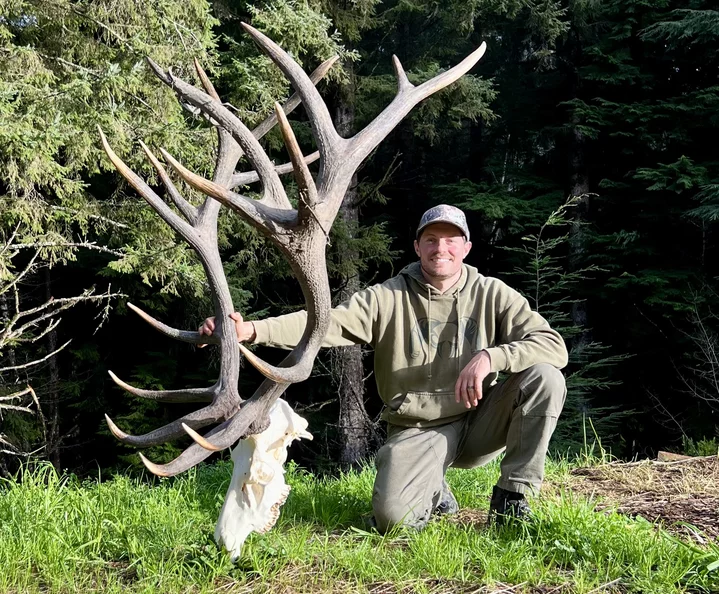Timothy Carpenter poses with his record-breaking antlers. | Submitted.
###
On a hunting trip this past September, McKinleyville-area resident Timothy Carpenter shot and killed a Roosevelt bull elk so improbably massive that he still has trouble wrapping his mind around it.
“The antlers on the bull are so large it’s a little confusing,” Carpenter told the Outpost in a phone interview this week.
He estimates the elk’s weight at somewhere around 900 pounds, and photos reveal its tree-like antlers to be as tall as a pair of teenage boys. It’s a genetic anomaly, like the Shaquille O’Neal of elk.
“Exactly,” Carpenter agreed. “Honestly, I’m still trying to figure it out.”
Earlier this month, a special judges panel convened by the nonprofit Boone & Crockett Club carefully measured the elk’s rack, tallying the length of its two main beams and their numerous forked tines. (The elk was an 8x9, in case you’re counting.)
Once the judges completed their measurements and added up the numbers, Carpenter’s elk was confirmed as the new world record. The official score of 455 2/8 inches smashed the previous world record by more than 30 inches.
In the weeks since, articles and photos of Carpenter with his record-breaking catch have proliferated across the surprisingly large number of hunting websites and periodicals, from Field and Stream and Game & Fish Magazine to more niche publications like Bugle Magazine: Journal of Elk Country and the Hunt.
“There’s a lot of them, actually; it’s kind of crazy,” he said. “My friend’s mom sent me one from Illinois the other day. It was in her hometown newspaper, printed. I said, ‘What?!’”
Carpenter, a hunting outfitter and wildlife biologist, grew up in the Bay Area and later earned his degree in wildlife management from Humboldt State University. He believes hunting goes hand-in-hand with conservation and has worked with ranchers, timber companies and other landowners to build tolerance for the prolific subspecies.
“I feel very fortunate to be doing what I’m doing … to establish those relationships where we can talk about conservation, where we can talk about management with hunting,” he told Bugle Magazine.
Carrington Hilson, an environmental scientist with the California Department of Fish and Wildlife, oversees elk research and management on the North Coast. She said hunting is one of the main management tools that humans have for elk in our region and across the state.
“We are privileged in the fact that we have a population of [Roosevelt] elk that has rebounded,” she said when reached by phone Thursday. “We now have approximately 2,500 [Roosevelt] elk on the North Coast,” meaning in Del Norte and Humboldt counties. While the agency didn’t start tracking population data for the local population until 2016, Hilson said their numbers have increased significantly in recent years.
While she and other wildlife managers want to enable continued population growth and range expansion for these local herds, their increased numbers have caused problems. Certain populations along the coast are increasingly involved in property damage and conflicts with humans.
“These elk along the coast are in high densities, and they’re also highly habituated, so they lack fear of humans,” Hilson said. “So we’re having situations where they are in people’s yards. They break fences; they destroy ornamental plants and fruit trees. We also have the situation where they are on larger ranches, and there [are] issues with production in regards to cattle and hay.”
CDFW issues a limited number of tags each elk hunting season. (Harvesting an elk without a tag is illegal.) Some tags are awarded on a point system based on information submitted in applications while others are distributed via lottery.
Carpenter, who also holds the archery world record for Roosevelt elk, said the odds of getting a tag in any given year are pretty low. Having grown up in the more urban confines of the Bay Area, he developed a love of the outdoors when his dad got him into the Boy Scouts and took him on hunting and fishing trips. His brother, who also studied wildlife management at Humboldt State and later got a job working in the woods, got Carpenter into hunting.
“I didn’t have much time to hunt for myself, and I just feel extremely fortunate to have been able to fill my tag with such an incredible animal,” he said. After harvesting the large bull at an undisclosed Humboldt County location, he and his friend quartered the carcass in the field and hauled every last bit of meat to the truck they’d arrived in, he said.
“Nothing left in the field but some bones that were picked clean,” he said. “I have been enjoying sharing and cooking the meat with many friends and family.” He added that he’s grateful that this mature bull had many years to spread its “incredible genetics.”
Later this year, the elk’s antlers will go on display in Springfield, Missouri, during the Boone and Crockett Awards. Carpenter still marvels at their size.
“The elk’s unbelievable,” he said. “Still my main feeling is I’m just extremely fortunate.”

CLICK TO MANAGE